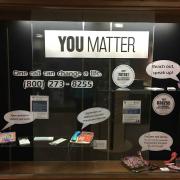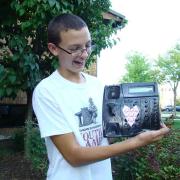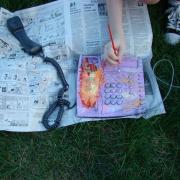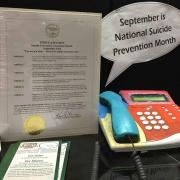Our teen volunteers painted and decorated the library’s old, discarded phones to be used as a display during Suicide Prevention Awareness Month (September).
Advanced Planning
This program began because of a scheduled upgrade to our phone system; our phones were too old to sell or donate onward. Our head of technology and I collaborated to come up with something fun the teens could do with the phones, and suicide awareness just seemed like the perfect topic. Once we’d come up with that, it was just a matter of choosing a date, making a supplies list and crossing our fingers for good weather.
I’m a fan of teen programming that’s not only fun, but also teaches new skills or does something useful. This program offered all of that; the fun of painting an unusual object like a landline phone, the skills needed for spray painting and the importance of suicide awareness.
Marketing
We advertised the program to our Teen Advisory Board, sent emails to our teen volunteers, used fliers in-house and promoted it on social media. As a result we had 32 teens sign up to help, some of whom hadn’t attended library programs before. For our teen programming, that level of sign-up is about on par with our best-attended programs.
Budgeting
Our budget for this program was fairly low, as the main ingredient (the phones) were items we already had, as were items like paintbrushes, permanent markers, paper plates for palettes and old newspaper to protect the grass. We bought six cans of spray paint for the teens to share, as well as small pots of acrylic paint.
One obvious way to lower costs would be to ask for donations. If people have spray paint lying around their garages, this would be a great way to use it up (provided, of course, that the paint is still good!), and would add an extra dimension of recycling to the program.
The same goes for phones — is there a local corporation that may have phones, keyboards or other items for communication that they no longer need? Some communities have technology recycling centers; they may have items they would be willing to donate for use.
Day-of-event Activity
We were lucky that the weather was perfect that evening, so we were able to meet outside. The teens helped to take the supplies outside and set up on the grass.
Each teen was responsible for pulling out a sheet of newspaper, selecting a phone, and setting up their workspace. We used the newspapers to protect the grass from the paint (and vice versa). The teens were fairly self-sufficient; as long as all the supplies were provided, we only needed me, with a camera, and one staff person to help grab everything I forgot!
Because it was an outside program and I had a brain-lapse that day, that second staff person was really essential. I stayed with the teens as the responsible adult, while my coworker grabbed cups of water and paper towels to clean brushes — something I hadn’t remembered to put on my list. But possibly our biggest challenge was getting all the phones indoors safely before it got dark and the library closed ... without getting paint all over ourselves or the library carts from the damp phones and newspapers!
Program Execution
On the evening of the program, 26 teens came to help — far more teens than I had expected. Altogether they created 29 colorful and inspirational phones to be displayed around the community, and several of them researched and added phrases of encouragement and/or the Suicide Prevention Hotline number to their phones. They used sites like suicidepreventionlifeline.org, afsp.org and www.veteranscrisisline.net as well as social media and their own inspiration to find things to say and resources to offer.
At the beginning of the program, the teens and I spoke briefly about suicide awareness: the stats, the resources, why it was important to let people know that it was OK to reach out if they needed to. At least half of the teens who attended indicated that they had lost someone to suicide or knew someone who had lost a loved one, but all the teens were excited about the purpose of this program.
In September, we put clusters of five phones up at both of the library’s branches, at the Farmington Hills City Hall and at the local community center. Two phones went to each of the four community high schools. All the displays included resource handouts as well as word balloon cutouts with words of encouragement.
Many members of the community responded with excitement and gratitude that this important topic was acknowledged. People shared stories with staff about family members or friends they had lost. I was privileged to speak with a few people who were suicide survivors; hearing their reactions to the displays was humbling. The pictures of the displays and the phones were shared multiple times on Facebook, reaching out to people who may be a suicide risk.
Advice
Possibly the biggest piece of advice is: be prepared for a mess! We asked the teens to wear old clothes they didn’t mind getting paint on, but that didn’t always register with them. Spray paint does tend to go places one doesn’t intend, so a quick tutorial is a good idea — and make sure to hold this event outdoors, if at all possible. Pay attention to wind speed and direction; you may need to designate “spray spots” and have the teens rotate through standing in those spots to use the spray paint, so the wind doesn’t carry it into other people’s faces.
Unless you are able to keep the phones outside for several hours while they dry, plan a safe place to store them inside the library. Also, figure out a way to get them to that spot quickly and without getting paint on anything. You may think about using wax paper or some other nonstick surface to lay handsets on so that they can dry without ending up with paper residue on them — or sticking to the phone cradles!
Our program was low-key and teen-directed, so we didn’t spend very long in the group setting talking about the effect suicide can have on those left behind. The teens were more focused on the future, on creating something to help those who are considering suicide. Every group is different; if you’re not comfortable talking about this topic or addressing questions the teens have, you might consider asking a local counselor or suicide prevention advocate to attend your program. There are SAFE (Suicide Awareness for Everyone) organizations in cities around the country, and the Youth Suicide Prevention Program in Washington State offers training through their safeTALK program.









